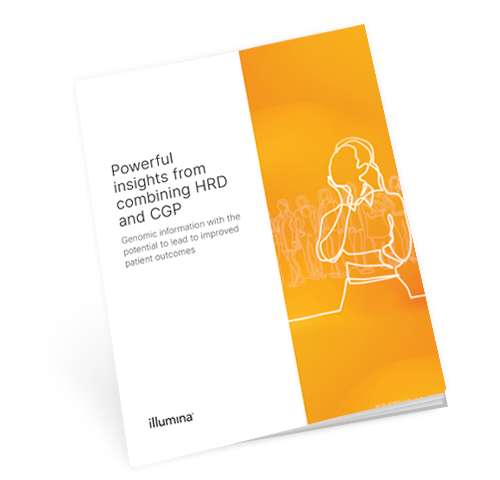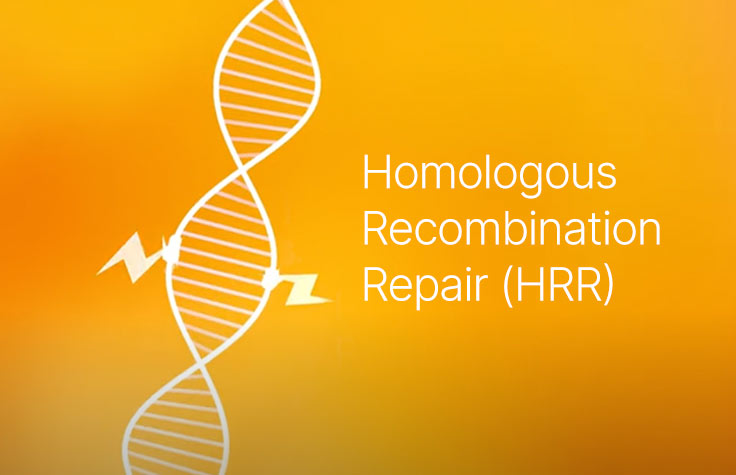HRD Detection in Cancer
What is homologous recombination deficiency?
Homologous recombination deficiency (HRD) describes when a cell loses its ability to repair double-strand DNA breaks, using the homologous recombination repair (HRR) pathway.1 When the HRR pathway is compromised, genomic alterations and genomic instability can occur, contributing to cancerous tumor growth. The resulting genomic scarring can be measured to evaluate HRD status.
Homologous recombination deficiency testing with next-generation sequencing (NGS) is emerging as a beneficial technology that can assess both causal genes and genomic scarring together, in one assay.
Defects in the homologous recombination repair pathway

Ovarian Cancer2
High-grade serous ovarian cancer (HGS-OvCa)
- 17% carried germline mutations in BRCA1/2
- 3% somatic mutations in BRCA1/2

Breast Cancer3
Triple-negative breast cancer (TNBC)
- 20% had either somatic or germline mutations in BRCA1/2

Prostate Cancer4
Metastatic castration resistant prostate cancer (mCRPC)
- ~19% had mutations in BRCA1/2, BRCAness genes (ATM, CDK12)

Pancreatic Cancer5
Pancreatic ductal adenocarcinoma (PDAC)
- 17% had germline mutations in BRCA2
- 24% germline or somatic mutations in BRCA1/2.PALB2
- 8% had mutations in ATM

The value of CGP for HRD detection
Comprehensive genomic profiling (CGP) is an approach that uses a single NGS assay to assess hundreds of genes for relevant cancer biomarkers, as established in guidelines and clinical trials, to guide therapy selection. HRD is a genomic signature that can be included with CGP testing, or as a stand-alone test.
CGP also has the power to identify rare mutations and other relevant genomic signatures in ovarian, breast, prostate, and pancreatic cancers such as tumor mutational burden (TMB) and microsatellite instability (MSI).
As our understanding of HRD in cancer expands beyond causal genes like BRCA1 and BRCA2, other genes that may affect the HRR pathway could be included in a comprehensive genomic profiling (CGP) test.

Potential therapies for HRD positive tumors
When a tumor exhibits homologous recombination deficiency, the patient may be eligible for treatment with PARP inhibitors. PARP inhibitor indications have expanded over the last few years, due to promising data generated from different clinical trials.6,7
Beyond current approved therapies for HRD-positive patients, comprehensive genomic profiling can help identify additional gene signatures and mutations which are either actionable or important for clinical trial enrollment to accelerate new therapeutic developments.
Homologous recombination deficiency (HRD) testing in ovarian cancer
Isabelle Ray-Coquard, MD, PhD, explains how CGP simultaneously provides HRD and BRCA status in ovarian cancer patients. She presents the case of a patient who benefited from CGP testing for these biomarkers and discusses how CGP can detect other actionable mutations.

Maximize your insights with HRD and CGP
Consolidated testing with CGP including HRD allows for more insight. Learn about the benefits of combining homologous recombination deficiency analysis with CGP testing.
Download free guideRelated Content
What short and long RNAs in liquid biopsy tell us about cancer
This webinar presents methodologies for sequencing long or short RNAs from liquid biopsy samples, along with implications for cancer research.
The transformational impact of comprehensive genomic profiling
Illumina showcases the impacts of CGP in unlocking precision medicine for cancer patients at ASCO.
Collaborating to evaluate the impact of in-house CGP to enhance patient care
Illumina and Allegheny Health Network to assess the efficacy of in-house testing for both tissue and blood samples and identify instances where blood-based testing is most beneficial.
References
- Lord.C., Ashworth, A BRCAness revisited Na Rey Cancer 16, 110-120(2016).
- The Cancer Genome Atlas Network. Comprehensive molecular portraits of human breast tumors. Nature 490.61-70(2012).
- The Cancer Genome Atlas Research Network Integrated genomic analyses of ovarian carcinoma. Nature 474, 609-615(2011).
- Robinson, D.et al. Integrative clinical genomics of advanced ceostatecancerCel161.1215-1228(2015).
- Waddel, N.et al. Whole genomes redefine mutational landscape of pancreatic cancer. Nature 518, 495-501(2015).
- Hussain M, Mateo J, Fizazi K, et al. Survival with Olaparib in Metastatic Castration-Resistant Prostate Cancer. N Engl J Med. 2020;383(24):2345-2357. doi:10.1056/NEJMoa2022485
- Ray-Coquard I, Pautier P, Pignata S, et al. Olaparib plus Bevacizumab as First-Line Maintenance in Ovarian Cancer. N Engl J Med. 2019;381(25):2416-2428. doi:10.1056/NEJMoa1911361

